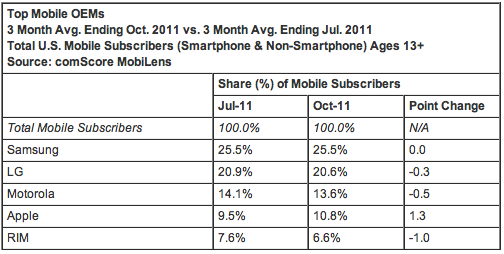IDC says 18.1 million media tablets were shipped in this year's third quarter, an increase of 264.5 percent compared with last year, and a quarter-on-quarter increase of 23.9 percent. Shipments fell short of IDC's original forecast of 19.2 million units, but the research company sees "strong demand" for this year's fourth quarter, thanks partly to shipments of Amazon's Kindle Fire and Barnes & Noble's Nook Color. IDC has therefore increased its forecast for 2011 slightly, from 62.5 million to 63.3 million units.
The forecasts cover media tablet shipments to channels, not sales to consumers.
Apple was the market leader, shipping 11.1 million units in this year's third quarter compared with 9.3 million units last time. Its market share slipped slightly from 63.3 percent to 61.5 percent. Samsung took a distant second place with a 5.6 percent market share. Hewlett-Packard was third with a 5.6 percent market share, followed by Barnes & Noble (4.4 percent) and Asus (4.0 percent).
HP entered and left the market during the quarter, shifting 903,354 units of its TouchPad, mostly at fire-sale prices. Barnes & Noble shipped 805,458 units, according to IDC.
RIM did not make the Top 5 table, having seen its shipments reportedly tumble from 500,000 units in this year's first quarter to 200,000 in Q2 and 150,000 in Q3 (when, thanks to price reductions, it sold more PlayBooks than it shipped).
The media tablet market is still small enough to be changed dramatically by individual product launches.
IDC says in a statement:
"After ceding share in 3Q11 (down to 32.4 percent from 33.2 percent the previous quarter), IDC expects Android to make dramatic share gains in 4Q11 growing to 40.3 percent. That increase is due mostly to the entrance of Amazon's Kindle Fire, and to a lesser extent the Barnes & Noble Nook Tablet, into the market. The share increase comes at the expense of Blackberry (slipping from 1.1 percent to 0.7 percent), iOS (slipping from 61.5 percent to 59.0 percent), and webOS (slipping from 5 percent to 0 percent). Despite
HP's announcement last week that it would contribute webOS to the Open Source community, IDC does not believe the operating system will reappear in the media tablet market in any meaningful way going forward."
The media tablet category is somewhat arbitrary. IDC used to count all of Barnes & Noble's products in the eReader category, which is dominated by the
Amazon Kindle range. Also, IDC may find it difficult to track sales of the Kindle Fire separately, since Amazon does not publish sales figures.
Separately, Amazon announced yesterday that "that Kindle devices remain the hottest products this holiday season – for the third week in a row, customers are purchasing well over 1 million Kindle devices per week, and Kindle Fire remains the #1 bestselling, most gifted, and most wished for product across the millions of items available on Amazon.com since its introduction 11 weeks ago."
@jackschofield  Apparently, there were 3.7 million Android activations just on December 24th and 25th alone. Pretty impressive numbers if you ask me. This leaves me wondering — did you guys get a shiny new Android device for Christmas? If so, which one?
Apparently, there were 3.7 million Android activations just on December 24th and 25th alone. Pretty impressive numbers if you ask me. This leaves me wondering — did you guys get a shiny new Android device for Christmas? If so, which one?






 6:44 PM
6:44 PM
 Simranpal SIngh
Simranpal SIngh











 [
[
























